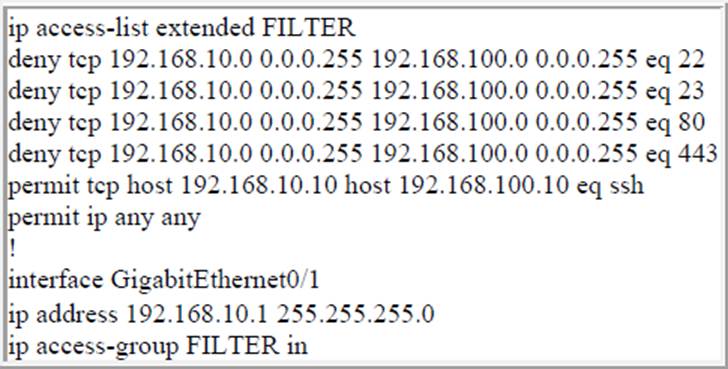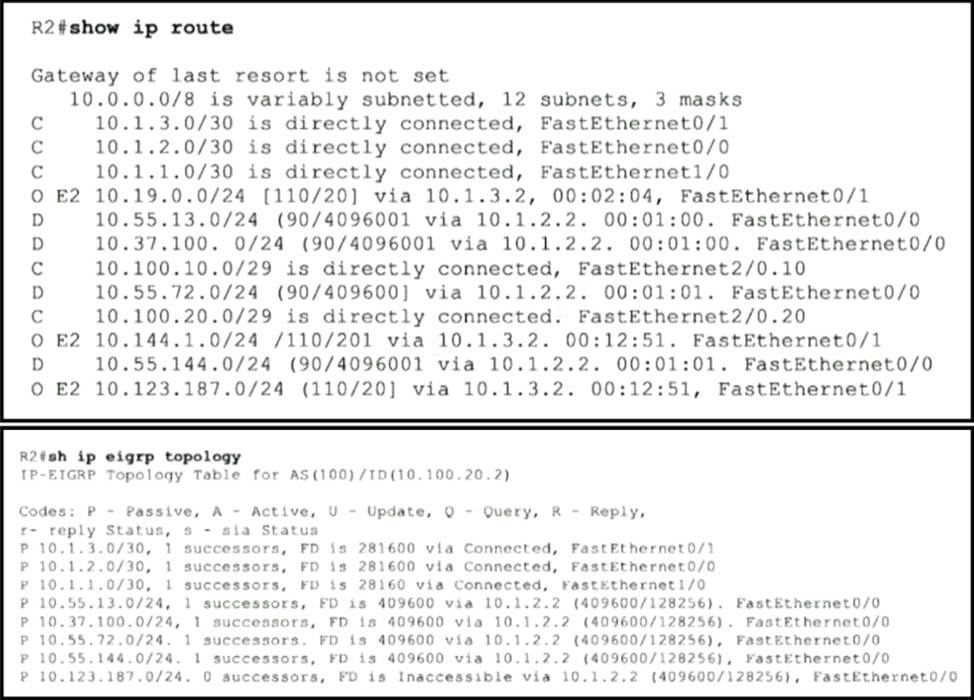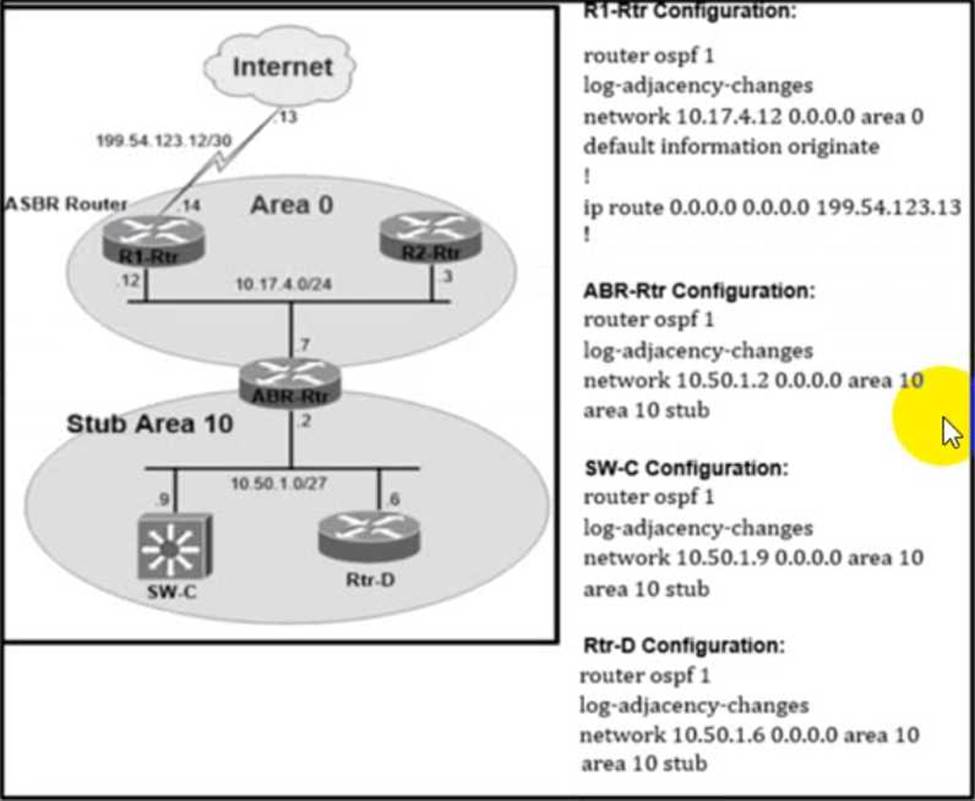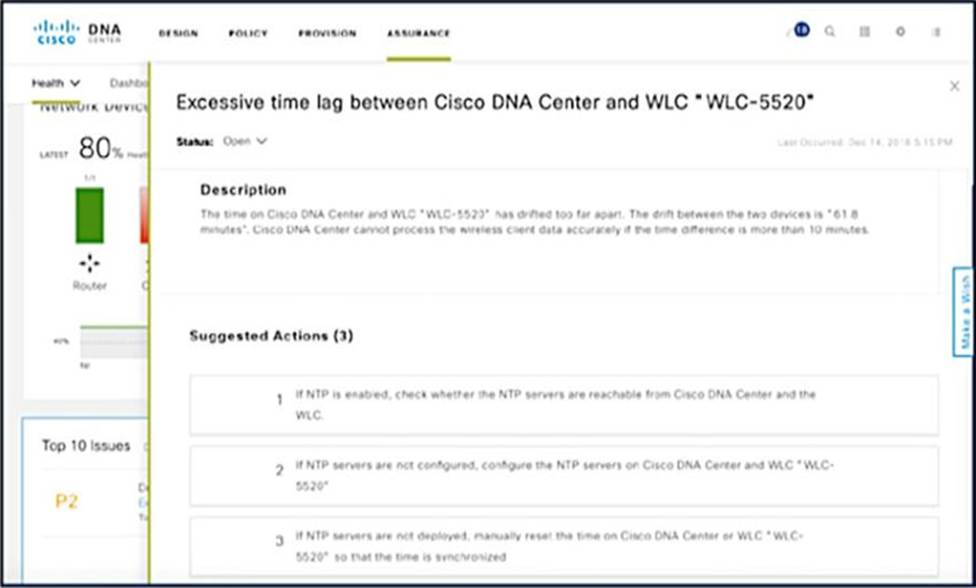Practice Free 300-410 Exam Online Questions
Refer to the exhibit.


Which subnet is redistributed from EIGRP to OSPF routing protocols?
- A . 10.2.2.0/24
- B . 10.1.4.0/26
- C . 10.1.2.0/24
- D . 10.2.3.0/26
DRAG DROP
Drag and drop the MPLS concepts from the left onto the descriptions on the right.


Explanation:
+ allows an LSR to remove the label before forwarding the packet: penultimate hop popping
+ accepts unlabeled packets and imposes labels: label edge router
+ group of packets that are forwarded in the same manner: forwarding equivalence class
+ receives labeled packets and swaps labels: label switch router
A label edge router (LER, also known as edge LSR) is a router that operates at the edge of an MPLS network and acts as the entry and exit points for the network. LERspush an MPLS label onto an incoming packet and pop it off an outgoing packet.
A forwarding equivalence class (FEC) is a term
Refer to the exhibit.

The ACL is placed on the inbound Gigabit 0/1 interface of the router. Host 192.168.10.10cannot SSH to host 192.168.100.10 even though the flow is permitted.
Which action resolves the issue without opening full access to this router?
- A . Move the SSH entry to the beginning of the ACL
- B . Temporarily move the permit ip any any line to the beginning of the ACL to see if the flow works
- C . Temporarily remove the ACL from the interface to see if the flow works
- D . Run the show access-list FILTER command to view if the SSH entry has any hit statistic associated with it
Refer to the exhibit.

A network administrator has developed a Python script on the local Linux machine and is trying to transfer it to the router. However, the transfer fails.
Which action resolves this issue?
- A . The SSH service must be enabled with the crypto key generate rsa command.
- B . The SCP service must be enabled with the ip scp server enable command.
- C . The Python interpreter must first be enabled with the guestshell enable command.
- D . The SSH access must be allowed on the VTY lines using the transport input ssh command.
B
Explanation:
The error “Administratively disabled” means we need to enable SCP on the router with the command: Router(config)#ip scp server enable
Refer to the exhibit.

Router R2 should be learning the route for 10.123.187.0/24 via EIGRP.
Which action resolves the issue without introducing more issues?
- A . Use distribute-list to modify the route as an internal EIGRP route
- B . Redistribute the route in EIGRP with metric, delay, and reliability
- C . Use distribute-list to filter the external router in OSPF
- D . Remove route redistribution in R2 for this route in OSPF
Refer to the exhibit.

Router ABR-Rtr is not propagating the internet routes in OSPF area 10. which causes internet reachability problems in the area.
Which action resolves the issue?
- A . ABR-Rtr must configure the default-information originate always command.
- B . ABR-Rtr must configure the area 10 stub no-summary command.
- C . ABR-Rtr network type must be broadcast network.
- D . ABR-Rtr must advertise the 0.0.0.0/0 default route in area 10.
Exhibit:

NTP is configured across the network infrastructure and Cisco DNA Center. An NTP issue was reported on the Cisco DNA Center at 17:15.
Which action resolves the issue?
- A . Check and resolve reachability between the WLC and the NTP server
- B . Reset the NTP server to resolve any synchronization issues for all devices
- C . Check and resolve reachability between Cisco DNA Center and the NTP server
- D . Check and configure NTP on the WLC and synchronize with Cisco DNA Center
D
Explanation:
Excessive time lag between Cisco DNA Center and device: The time difference between Cisco DNA Center and the device IP Address has drifted too far apart. Cisco DNA Center cannot process the device data accurately if the time difference is more than 3 minutes.
Reference: https://www.cisco.com/c/en/us/td/docs/cloud-systems-management/network-automation-and-management/dna-center-assurance/1-2-10/b_cisco_dna_assurance_1_2_10_ug/b_cisco_dna_assurance_1_2_10_ug_chapter_01101.html
An engineer configured a Cisco router to send reliable and encrypted notifications for any events to the management server. It was noticed that the notification messages are reliable but not encrypted.
Which action resolves the issue?
- A . Configure all devices for SNMPv3 informs with priv.
- B . Configure all devices for SNMPv3 informs with auth.
- C . Configure all devices for SNMPv3 traps with auth.
- D . Configure all devices for SNMPv3 traps with priv.
A
Explanation:
SNMP notifications can be sent as traps or inform requests. Traps are unreliable because the receiver does not send acknowledgments when this device receives traps.”Send reliable and encrypted notifications for any events” so it is SNMP notifications. For encryption we need to configure “priv”.
What are two functions of MPLS Layer 3 VPNs? (Choose two.)
- A . LDP and BGP can be used for Pseudowire signaling.
- B . It is used for transparent point-to-multipoint connectivity between Ethernet links/sites.
- C . BGP is used for signaling customer VPNv4 routes between PE nodes.
- D . A packet with node segment ID is forwarded along with shortest path to destination.
- E . Customer traffic is encapsulated in a VPN label when it is forwarded in MPLS network.
C,E
Explanation:
MPLS Layer-3 VPNs provide IP connectivity among CE sites* MPLS VPNs enable full-mesh, hub-andspoke, and hybrid IP connectivity* CE sites connect to the MPLS network via IP peering across PE-CE links* MPLS Layer-3 VPNs are implemented via VRFs on PE edge nodes* VRFs providing customer routing and forwarding segmentation* BGP used for signaling customer VPN (VPNv4) routes between PE nodes* To ensure traffic separation, customer traffic is encapsulated in an additional VPN label when forwarded in MPLS network* Key applications are layer-3 business VPN services, enterprise network segmentation, and segmented layer-3 Data Center access
Reference: https://www.ciscolive.com/c/dam/r/ciscolive/us/docs/2018/pdf/BRKMPL-1100.pdf
What is a role of route distinguishers in an MPLS network?
- A . Route distinguishers define which prefixes are imported and exported on the edge router
- B . Route distinguishers allow multiple instances of a routing table to coexist within the edge router.
- C . Route distinguishers are used for label bindings.
- D . Route distinguishers make a unique VPNv4 address across the MPLS network
